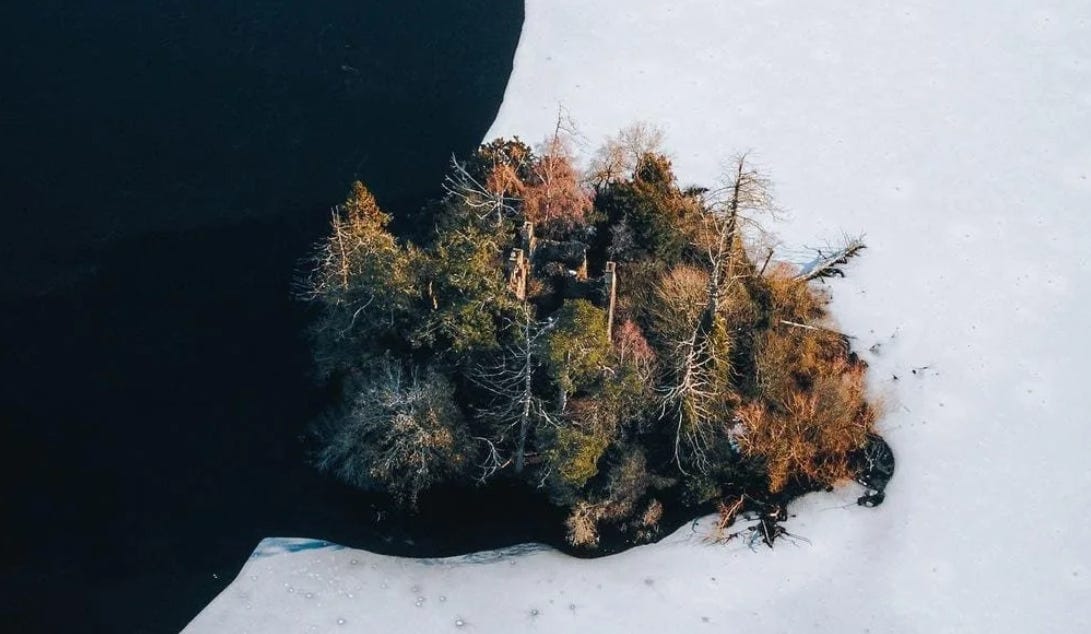Amid the gentle hills of Perthshire, not far from Dunkeld, lies a modest loch with a dramatic secret. Loch Clunie, though small in size, offers a scene rich in contrast—a calm, reflective lake nestled in peaceful countryside, interrupted only by a small wooded island. But look closer. Perched on that island, nearly filling it from edge to edge, is a structure that seems lifted from the middle ages: a house as large as the land it occupies, ancient and impenetrable. This is the fortress house of Clunie Island, and its existence is a testament to an era when security wasn’t just a concern—it was a necessity.
Today, we explore this strange, compelling relic of feudal life: part residence, part fort, part symbol of a world where the wheels of a coach could not reach, and where isolation meant survival.
Island Fortresses: A Highland Strategy
The Highlands are full of castles and fortified houses perched on islands. From the iconic Eilean Donan to the lesser-known Castle Stalker, the Scottish landscape practically invented the scenic defensive outpost. But Clunie stands out, not for grandeur, but for its peculiar intimacy. The island is small—so small, in fact, that the house built upon it barely allows for anything else. It's less an island with a house, and more a house as an island.
Why this architectural eccentricity?
In the days of clan rivalries, cattle raiding, and sudden blood feuds, homes were not just places of comfort—they were strongholds. To live on an island meant physical separation from would-be attackers. No bridge connected Clunie to the mainland. And without modern boats or barges, anyone hoping to approach uninvited would need to swim, row, or wait for an invitation.
For the Lords Airlie—the Ogilvies, who called this island home—such protection was not just symbolic. As a noble family operating on the borders of Highland and Lowland Scotland, security was always a top concern. But in building this island home, they also made a quiet, powerful statement: we answer to no one but ourselves.
The House as a Statement: Isolation, Power, and Identity
Clunie’s fortress house is not large by castle standards, but its placement and proportions are bold. It dominates the loch not through height or ornament, but by presence—its stubborn, square footprint feels defiant. As if it were saying: This is ours. All of it. The structure has the air of a place not easily visited, not easily understood.
In an age before phones, satellites, or even reliable postal routes, this was intentional. Clunie’s island house didn’t just keep enemies at bay—it kept society at arm’s length. As our original source puts it with a sly wink: “No wheels of coach or barouche can shake his foundations, no nightly flambeaus will glitter on his ceilings, nor thundering footman rouse his echoes.”
It’s a poetic way of saying: no one drops in on Clunie.
This isolation, once essential for survival, today lends the island a certain mystique. We marvel at how complete the retreat is. No bridge. No modern buildings cluttering the shore. It remains, more or less, as it was—a time capsule of Highland life.
An Artist’s Obsession, A Historian’s Puzzle
The house on Clunie Island has fascinated not just casual visitors, but artists, writers, and historians. For artists, it’s a dream scene: still water, softened hills, and that one solitary structure—weathered by centuries, but upright and stubborn.
For historians, it’s more complicated.
Records of the building are sparse, and though oral history suggests it belonged to the Ogilvies, detailed documentation is thin. Was it built as a last resort against attack, or as a status symbol? Did it house family year-round, or serve as a seasonal refuge? Like much in Scottish history, the facts blur into folklore.
One thing is clear: the structure is one of the most intact examples of domestic island fortresses in this part of Scotland. Its setting—tranquil, yet unmistakably guarded—captures a mindset from another time. A time when hospitality could be dangerous, and solitude was a luxury money couldn't always buy.





